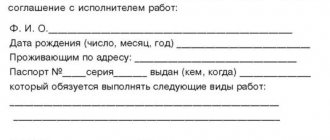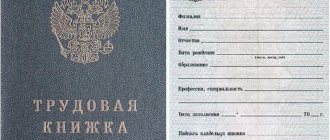Important information! We are no longer recording the issuance of soap and detergents to employees!
Greetings, dear friends! Truly good news awaits you here. Our legislators from the Russian Ministry of Labor are implementing measures according to the “road map”, which I wrote about not long ago. We are talking about the abolition of the excessive requirement in part of Order No. 1122n - also known as the Standard Standards for the free provision of flushing and/or neutralizing agents to employees, also known as the labor safety standard “Providing workers with flushing and/or neutralizing agents.”
Standards for issuing soap to employees in 2020, as amended
At certain jobs, the employer is required to provide soap to employees according to special standards. In 2020, there were changes to the rules. The article contains all the necessary information on the issue of issuing soap.
Changes in soap distribution
From June 12, 2020, employers must, according to new rules, issue soap to employees. This follows from the order of the Ministry of Labor. These changes apply in 2020.
Companies will not have to record soap dispensing on record cards. The obligation is canceled if the work involves light pollution (Order of the Ministry of Labor dated November 23, 2017 No. 805n, which comes into force on June 12).
How to take into account the standards for issuing soap under the simplified tax system
The magazine “Simplified” published an article about problematic expenses under the simplified tax system. The Ministry of Finance prohibited taking into account some expenses. Find out right now whether there are standards for dispensing soap among them.
How to include a soap clause in a contract
Include in the employment contract a provision for the provision of flushing and neutralizing agents if the employee is engaged in work with contaminants (letter of the Ministry of Labor dated August 18, 2016 No. 15-2/OOG-3000). You will find a list of such works in the Standard Standards. They were approved by the Ministry of Health and Social Development by order No. 1122n dated December 17, 2010 (see table at the end of the article).
If there is no provision in the contract for the issuance of special equipment, draw up an additional agreement (sample below). Otherwise, labor inspectors will impose a fine (Part 1 of Article 5.27 of the Code of Administrative Offenses of the Russian Federation):
Example of an entry in a contract
“The employee is given flushing and (or) neutralizing agents once a month: 200 grams of toilet soap or 250 ml of liquid soap in dispensing devices”
How to dispense soap in the office
The company is not obliged to issue soap and include this condition in the employment contract if the work is not specified in the Model Standards. For example, there is no need to give soap to office workers - accountants, secretaries, economists, managers (letter of the Ministry of Labor dated May 6, 2016 No. 15-2/OOG-1752).
In offices, it is enough to put soap in the toilet.
Thus, it is not necessary to provide soap to office workers. Soap is provided to employees when working with easily and difficult to wash off stains. For example, in coal mines and open-pit mines, in processing and briquette factories, in coal industry organizations.
Fines
Standard standards for issuing soap were approved by order of the Ministry of Health and Social Development of Russia dated December 17, 2010 No. 1122n. If soap is not provided to employees, they face a fine in the amount (part 3 of article 5.27 of the Code of Administrative Offenses of the Russian Federation):
Soap dispensing standards
These indicators were approved by order of the Ministry of Health dated December 17, 2010 No. 1122n.
Name of work and production factors
Issue rate per 1 employee per month
I. Protective means
Hydrophilic agents (moisture-absorbing, skin moisturizing)
Work with organic solvents, technical oils, lubricants, soot, varnishes and paints, resins, oil and petroleum products, graphite, various types of industrial dust (including coal, metal, glass, paper and others), fuel oil, fiberglass, lubricants oil-based liquids (hereinafter referred to as coolants) and other water-insoluble materials and substances
Hydrophobic agents (moisture repellent, drying skin)
Work with aqueous solutions, water (provided for by the technology), water-based coolants, disinfectants, solutions of cement, lime, acids, alkalis, salts, alkali-oil emulsions and other water-soluble materials and substances; work performed in rubber gloves or gloves made of polymer materials (without natural lining), closed safety shoes
Combined action agents
Work with bacterially hazardous environments; when the workplace is located remotely from stationary sanitary facilities; work performed in closed special shoes; with increased requirements for hand sterility in production
Means for protection against biological harmful factors (from arthropod bites)
External work (seasonal, at temperatures above 0°C) during the period of activity of blood-sucking and stinging insects and arachnids
II. Cleansers
Soap or liquid detergents including:
200 g (toilet soap) or 250 ml (liquid detergents in dispensing devices)
300 g (toilet soap) or 500 ml (liquid detergents in dispensing devices)
Cleansing creams, gels and pastes
III. Regenerating, restorative agents
Regenerating, restorative creams, emulsions
Work with organic solvents, technical oils, lubricants, soot, varnishes and paints, resins, petroleum and petroleum products, graphite, various types of industrial dust (including coal, glass and others), fuel oil, water- and oil-based coolants, with water and aqueous solutions (provided for by the technology), disinfectants, solutions of cement, lime, acids, alkalis, salts, alkali-oil emulsions and other working materials; work performed in rubber gloves or gloves made of polymer materials (without natural lining); negative impact of the environment
Distribution of soap and detergents in 2020
Based on the title of this note, attentive readers correctly guessed that we are talking about the abolition of the requirement to record the issuance of soap or liquid detergents to employees, including for washing hands and bodies, in a personal card for recording the issuance of rinsing and (or) disinfectants. This is true. According to the amendments, paragraph three of paragraph 24 now reads as follows:
The issuance of flushing and (or) neutralizing agents to employees, with the exception of the products specified in paragraph 7 of the Model Standards, must be recorded against signature in a personal card for recording the issuance of flushing and (or) neutralizing agents, a sample of which is provided in the appendix to the Standard.
As you probably remember, point 7 is about soap or liquid detergents when working with easily washed off contaminants . Not to be confused with item 8, which includes solid toilet soap or liquid detergents - issued for work involving difficult to wash off, persistent contaminants: oils, lubricants, petroleum products, varnishes, paints, resins, adhesives, bitumen, fuel oil, silicone, soot, graphite, various types of industrial dust (including coal, metal), as well as when working in coal (shale) mines, in open-cast mines, in processing and briquette factories, in mine construction and mine installation organizations in the coal industry.
But this is not the only change.
We read paragraph 9 in the current version:
9. The standards for issuing flushing and (or) neutralizing agents that correspond to the working conditions at the employee’s workplace are specified in the employee’s employment contract.
We read paragraph 9 in the future edition:
9. The standards for the issuance of flushing and (or) neutralizing agents that correspond to the working conditions at the employee’s workplace are specified in the employee’s employment contract or in the local regulatory act of the employer, and are brought to the attention of the employee in writing or electronically in a way that allows confirming the employee’s familiarity with these standards .
Let's draw conclusions.
Now the most important thing. All the changes described above are made by order of the Ministry of Labor of Russia dated November 23, 2017 No. 805n “On amendments to Appendix No. 2 to the order of the Ministry of Health and Social Development of the Russian Federation dated December 17, 2010 No. 1122n “On approval of standard standards for the free issuance of flushing products to employees and (or) disinfectants and the labor safety standard “Providing workers with flushing and (or) disinfectants.” Order No. 805n, as befits a normative legal act, is registered with the Ministry of Justice of Russia and published on the official Internet portal of legal information. In accordance with paragraph 2 of Order No. 805n, the changes come into force six months after official publication, i.e. June 12, 2018 .
There is still a long time until the summer of 2020, so we can slowly prepare a new version of the regulation on providing workers with flushing and disinfecting agents.
Standard standards for the free distribution of flushing and (or) neutralizing agents to employees (fragment)
| N p/p | Types of rinsing or disinfecting agents | Name of work and production factors | Issue rate per employee per month |
| Cleansers | |||
Soap or liquid detergents, including:
| Work related to easily washed off contaminants | 200 g of toilet soap or 250 ml of liquid soap in dispensing devices | |
| 300 g of toilet soap or 500 ml of liquid soap in dispensing devices | ||
| Solid toilet soap or liquid detergents | Work involving hard-to-remove, persistent contaminants (oils, greases, petroleum products, varnishes, paints, resins, adhesives, bitumen, fuel oil, silicone, soot, graphite, various types of industrial dust, including coal and metal) | 300 g of toilet soap or 500 ml of liquid soap in dispensing devices | |
| Work in coal and shale mines, in open-cast mines, in processing and briquette factories, in mine construction and mine installation organizations in the coal industry | 800 g of toilet soap or 750 ml of liquid soap in dispensing devices | ||
| Cleansing creams, gels and pastes | Work involving hard-to-remove, persistent contaminants (oils, greases, petroleum products, varnishes, paints, resins, adhesives, bitumen, fuel oil, silicone, soot, graphite, various types of industrial dust, including coal and metal) | 200 ml |
Clause 7 of the Model Standards mentions work involving easily washable contaminants. What exactly is considered such work? This is not explained either by the Model Norms themselves or by the Standard.
During inspections, labor inspectors insist that employment contracts with secretaries, lawyers, managers and other office workers must specify the standards for issuing them toilet or liquid soap. Accountants and personnel officers write about this on forums.
The concept of “work associated with easily washed off contaminants” is disclosed in the Order of JSC Russian Railways dated December 17, 2012 N 2587r. Although this document is a local regulatory act of Russian Railways, we will use it to clarify the situation.
So, easily washed off pollutants include, in particular:
- organic solvents;
- various types of industrial dust (wood, siliceous, etc.);
- fiberglass;
- cement, lime;
- disinfectants;
- acids, alkalis, salts, etc.
As you can see, the list of easily washable pollutants is quite specific. It is unlikely that the work duties of a secretary or accountant are associated with such harmful production factors.
DOWNLOAD DOCUMENT
Order of the Ministry of Labor of Russia dated November 23, 2017 No. 805n “On amendments to Appendix No. 2 to the order of the Ministry of Health and Social Development of the Russian Federation dated December 17, 2010 No. 1122n
Current edition:
Standard standards for the free distribution of flushing and/or neutralizing agents to employees and the labor safety standard “Providing employees with flushing and/or neutralizing agents,” approved by Order of the Ministry of Health and Social Development of Russia dated December 17, 2010 No. 1122n
Don’t forget to put rating stars, unsubscribe in the comments, subscribe to the newsletter for current news and materials










